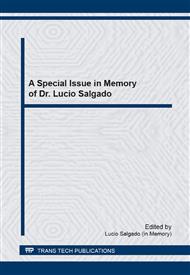p.362
p.368
p.374
p.380
p.386
p.395
p.403
p.409
p.415
High-Velocity Impact Comminution of Magnetite
Abstract:
Conventional comminution (crushing and grinding) uses compressive forces to initiate and propagate cracks throughout the rock mass, yet the material actually breaks under tension since this strength characteristic is about 10 percent of the compressive strength. Converting a compressive force into a tensile one is inefficient - of the order of 1 to 2 percent. On the other hand, blasting shows energy efficiencies of the order of 10 to 20%. Part of this difference is due to forces being applied directly in tension (from the inside-out), but also because the velocity of impact is orders of magnitude higher (10,000 m·s-1 versus 10 m·s-1), i.e., the rate of energy input is very high (micro-seconds vs. seconds in conventional comminution). This paper reports on studies that show how the energy efficiency of comminution can be enhanced by high-velocity impact. This research project has carried out investigations into the relationship between energy efficiency with energy input level and impact velocity during rock fragmentation by metal projectiles. The project has also examined rock-on-rock breakage. Samples of magnetite particles of varying weights and size distributions were impacted by a projectile at velocities from 50 m·s-1 to 400 m·s-1. The specific surface area of the sample was measured before and after each experiment, and the energy recovered as new surface energy (energy efficiency) was calculated. The results indicate that energy efficiency increases to about 5% as impact velocity enters the range from 200 to 300 m·s-1. This efficiency is over 3 times that observed in conventional comminution. Above this velocity, the efficiency begins to fall off although significant comminution at higher than normal efficiencies are still attained. The improvement results from both increased rate of energy input and increased impact velocity. Rock-on-rock impacts using a glass projectile shows that the energy of new surface generation is distributed between the projectile and the sample to a combined level similar to that of the steel-on-rock tests in which all the useful energy is retained within the sample. Suggestions are given as to how this energy improvement could be scaled-up into an impact crusher.
Info:
Periodical:
Pages:
386-394
Citation:
Online since:
September 2014
Authors:
Keywords:
Price:
Сopyright:
© 2015 Trans Tech Publications Ltd. All Rights Reserved
Share:
Citation:


